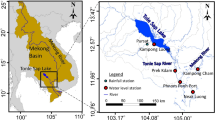Abstract—
An attempt has been made to construct models that approximate the time-range statistical properties of the useful inflow into Lake Baikal and its relationships with potential predictors that permit predictive assessments to be obtained. The problem solution consists of two parts. In the first part, the constructed physical and statistical models record the known patterns of runoff from the catchment. These patterns are subject to significant regression relationships between the predicted value of the monthly inflow and its hydrometeorological predictors. These models can be used to forecast the average useful inflow for the next month. The predictive correction for interannual variability to the seasonal inflow wave in these models is based on variability in the predictor values that are known at the forecasting time. The second part of the research is focused on possible trends and cycles in the interannual variability in useful inflow in the most water-abundant third quarter in order to predict it with a lead time of 1 year or more. Various cycle models with parameters estimated using the training sampling set do not provide a stable solution in the control sampling set. The best result has been obtained by a cyclical model with fixed periods, which records the possible impact on the inflow variability provided by gravitational influence of the Moon and major planets on the Earth and the Sun. Nevertheless, this model also should not be considered statistically significant due to the small proportion of the explainable variance and insufficiency of the data on useful inflow into Baikal.


Similar content being viewed by others
REFERENCES
Abasov, N.V., Berezhnykh, T.V., and Reznikov, A.P., Long-term forecasting of natural factors in the energy sector, Sistemnye issledovaniya problem energetiki (System Studies of Energy Problems), Novosibirsk: Nauka, 2000, pp. 415–429.
Bendaruk, S.E. and Motovilov, Yu.G., Information support technology in the management of reservoir cascades, Gidrotekh. Stroit., 2017, no. 7, pp. 22–35.
Kuchment, L.S., Matematicheskoe modelirovanie rechnogo stoka (Mathematical Modeling of River Flow), Leningrad: Gidrometeoizdat, 1972.
Burakov, D.A., Mathematical model for calculating spring floods for lowland swampy basins, Meteorol. Gidrol., 1978, no. 1, pp. 49–59.
Vinogradov, Yu.B., Matematicheskoe modelirovanie protsessov formirovaniya stoka (Mathematical Modeling of Runoff Formation Processes), Leningrad: Gidrometeoizdat, 1988.
Gel'fan, A.N., Dinamiko-stokhasticheskoe modelirovanie formirovaniya talogo stoka (Dynamic-Stochastic Modeling of the Formation of Melt Runoff), Moscow: Nauka, 2007.
Burakov, D.A., Gordeev, I.N., Ignatov, A.V., Petkun, O.E., Putintsev, L.A., and Chekmarev, A.A., Forecasting the water inflow into the Krasnoyarsk and Sayano-Shushenskoe reservoirs in the second quarter of the year, Geogr. Nat. Resour., Geogr. Prir. Resur., 2016, no. 2, pp. 175–183.
Zavalishin, N.N., Instruktsiya po rabote s programmnymi sredstvami tekhnologii “Kassandra-Sibir’” (Instructions for Working with the Software of the “Kassandra-Siberia” Technology), Novosibirsk: SibNIGMI, 2010.
Explanatory Note to the Draft Rules for the Use of Water Resources of the Irkutsk Reservoir and Lake Baikal. http://pivr.enbvu.ru/. Accessed September 9, 2019.
Ignatov, A.V., Rukovodstvo pol’zovatelya programmy “Stokhasticheskoe modelirovanie” (User’s Manual for the Program “Stochastic Simulation”), Irkutsk: Inst. Geogr. Sib. Otd. Ross. Akad. Nauk, 2019.
Jacoby, G.C., D’Arigo, R.D., and Davaajamts, T., Mongolian tree-rings and 20th century warming, Science, 1996, vol. 273, pp. 771–775.
Scafetta, N., A shared frequency set between the historical mid-latitude aurora records and the global surface temperature, J. Atmos. Solar-Terr. Phys., 2012, vol. 74, pp. 145–163.
Antonov, A.E. and Yakushev, D.I., Polyharmonic model of the Caspian Sea level and long-term forecast of its change, Navig. Gidrogr., 2011, no. 31, pp. 60–64.
Drozdov, O.A. and Grigor’eva, A.S., Mnogoletnie tsiklicheskie kolebaniya atmosfernykh osadkov na territorii (Long-Term Cyclical Fluctuations of Atmospheric Precipitation on the Territory of the USSR), Leningrad: Gidrometeoizdat, 1971.
Sherstyukov, B.G., Regional’nye i sezonnye zakonomernosti izmenenii sovremennogo klimata (Regional and Seasonal Patterns of Changes in the Modern Climate), Obninsk: Vseross. NII Gidromet. Inf., 2008.
Sherstyukov, B.G., Izmeneniya, izmenchivost' i kolebaniya klimata (Climate Change, Variability, and Fluctuations), Obninsk: Vseross. NII Gidromet. Inf., 2011.
Sidorenkov, N.S., Lunar-solar tides and atmospheric processes, Priroda, 2008, no. 2, pp. 23–31.
Monin, A.S., Influence of planets on the Earth’s climate, in Global’nye izmeneniya prirodnoy sredy (Global Changes in the Natural Environment), Moscow: Nauchn. Mir, 2000, pp. 122–128.
Box, J.E.P. and Jenkins, G.M., Time Series Analysis Forecasting and Control, San Francisco: Holden-Day, 1970.
Motovilov, Yu.G., A system of physical and mathematical models of river runoff formation and its application for hydrological calculations and forecasts, Extended Abstract of Doctoral (Geogr.) Dissertation, Moscow, 2019.
Millionshchikova, T.D., Modeling and pre-calculation of long-term changes in the Selenga river runoff, Extended Abstract of Cand. Sci. (Geogr.) Dissertation, Moscow, 2019.
Funding
This work was carried out under the research project of the Sochava Institute of Geography, Siberian Branch, Russian Academy of Sciences (project no. 0347-2016-003), and under the Scientific Cooperation Contract between the Institute of Geography, Siberian Branch, Russian Academy of Sciences, and the Siberian Regional Research Hydrometeorological Institute of the Ministry of Natural Resources and Ecology of the Russian Federation.
Author information
Authors and Affiliations
Corresponding authors
Additional information
Translated by E. Maslennikova
Rights and permissions
About this article
Cite this article
Ignatov, A.V., Zavalishin, N.N. Patterns and Models of Variability in the Useful Inflow into Lake Baikal. Geogr. Nat. Resour. 42, 37–43 (2021). https://doi.org/10.1134/S187537282101008X
Received:
Revised:
Accepted:
Published:
Issue Date:
DOI: https://doi.org/10.1134/S187537282101008X




